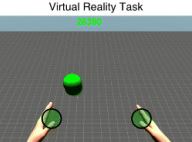http://blogs.biomedcentral.com
Autor: Judith Deutsch & Gerry Fluet
The use of virtual reality to improve limb use after stroke has been investigated in recent work published in the Journal of NeuroEngineering and Rehabilitation. Here, Judith Deutsch, Associate Editor for the journal, and Gerry Fluet from Rutgers University, explain more about this technique.
1
Using virtual reality to improve limb use post-stroke
Ballester et al., 2015
The first application of motor imagery
Building on the work of visual imagery and visual perception, and the mental practice of relearning limb function, motor imagery was first applied to the rehabilitation of walking for persons post-stroke by Francine Malouin’s group and my colleague and collaborator Ruthy Dickstein.
The work validated imagery potential for walking tasks in healthy persons and for persons post-stroke, as well as behavioral improvements and neuroplastic changes associated with motor imagery.
More recent studies based on Pavio’s and Guillot’s motor imagery theories, combined motor learning performance, motivation and self confidence as well as problem solving to address the walking goal.
In other words, they incorporate visualization of success as a strategy to increase self-efficacy. Imagining movement allowed the clinicians to create virtual environments and contexts for training that was not readily available in the real world.
Such virtual reality offered a similar appeal to motor imagery, with the potential to have more control over the content and the presentation of the stimuli. The application of virtual reality to improve walking post-stroke was initiated by Jaffe and Brown.
How does virtual reality work?
Participants viewed their steps from as if they were out of their body and looking from the side. The virtual environment allowed an enhanced view of the person’s action, which facilitated stepping over the virtual obstacles.
They demonstrated that training in virtual reality was superior to real world training as it transferred to improved walking over an obstacle course and fast walking.
Building on this, the study published in Journal of Neuroengineering and Rehabilitation by Rubio Ballester and colleagues, manipulates visual feedback for the purpose of shaping upper extremity motor behavior in people with chronic hemiparesis.
The visual feedback of larger amplitude movements or the higher success rate of the magnified movements result in the subjects choosing to use their paretic upper-extremity more often than they did prior to the intervention.
The authors combine elements of the motor imagery work (namely goal setting and self-efficacy) and elements of virtual reality (specifically augmenting amplitude and extent of a reaching movement to facilitate enhance motor performance).
What did they find?
The authors show virtual feedback representing larger amplitude movements of the paretic arms than the non-paretic arms. The magnified movements are more successful in the achievement of the virtual reaching task than unmagnified movements.
Either the visual feedback of larger amplitude movements or the higher success rate of the magnified movements result in the subjects choosing to use their paretic upper-extremity more often than they did prior to the intervention.
As with many other feedback distortion approaches, this change in motor behavior is transient, with returning to baseline after normal feedback conditions are restored.
What other work has been done in this field?
Several groups have investigated the manipulation of gain in the virtual environment to modify motor behavior by augmenting errors or magnifying movement. Both visual and haptic magnification of errors during virtual tasks presented with the goal of normalizing movement patterns has been investigated with measurable after-effects immediately following intervention and preliminary evidence for its efficacy as a treatment technique.
Other authors have used hypermetric visual feedback to increase the salience of these movements, by transforming movements too small to contribute to real world task performance into meaningful virtual world motor behavior.
Furthermore, others have utilized hypometric visual feedback presented during finger movements to increase cortical excitability in persons with stroke and by another group to shape the ability to modulate finger activity in a participant with stroke. There are, it appears, multiple ways to stimulate movement or cortical representations of movement.
A specific and positive way to augment performance

Ballester and colleagues have carefully measured the effects of augmenting movement on perceived self-efficacy and motor performance. Additionally they describe the effects of previous movements and whether participants had success with the movement.
What is so nice about this experiment is that it offers a specific and positive way to augment performance, and thus could be embedded as an algorithm to modulate upper limb (as well as lower limb) use. The authors interpret their work relative to non-use and suggest that it is in fact related to self-efficacy rather than challenges with motor performance.
Alternatively this could be related to motivation, or an interaction of both. Untangling the effects of virtual environments is complicated and this work is a good start.
The authors of this paper, along with others, presented their work at the International Conference on Virtual Rehabilitation held in Valencia from 9-12 June. If the publications in this meeting are a hint of what one could expect from virtual reality for rehabilitation of persons post-stroke in the next five years, look for greater harnessing of biological signals to drive movements in virtual environments, use of augmented reality, refinement of algorithms, neurophysiologic mechanistic studies to complement behavioral outcomes and hopefully deployment of affordable technologies that may be implemented in the clinic.